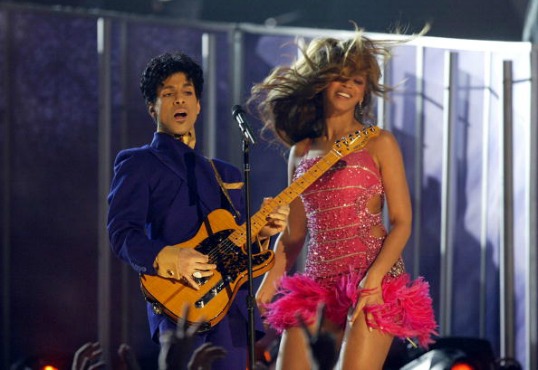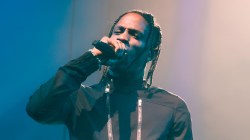When defining the origins of rock & roll, the Wikipedia encyclopedia begins with:
“The immediate roots of rock & roll lay in the rhythm and blues then called “race music.”
However, despite the clear, direct lineage between rock & roll and African-American creators, during the early days of MTV rock and roll music felt like it was banned to many people of color. In the early 80s, rock & roll and it’s screaming guitars felt restricted and foreign to many black kids, although it was born from the fingers of brown-skinned guitar icons like Chuck Berry, Jimmy Preston, Bo Diddley and Sister Rosetta Tharpe. When the Rolling Stones were showing out in the US with licks created by blues legends like Muddy Waters, black rockers in America were not played on the radio and also not encouraged or allowed to participate fully in the birth of the MTV generation.
Organizations like the Black Rock Coalition would eventually protest and fight to be heard by organizing black rock bands in New York City to form allegiances and do joint concerts, but before that, there was only Prince.

AD LOADING...
Against all odds, and in defiance of the strict regimen of pop culture, Prince not only refused to conform to any standards, but also continued to find ways to forcefully bend and break all of the music industry rules set before him. Even when funk and disco ruled in the black community, Prince had his first hit pop/rock album in 1979, releasing another rock-influenced hit album every year that he produced and often played the majority. if not all, of the instruments. He took his first break from releases in 1983, as 1984 was the year he finished writing, perfecting, starring in and then releasing his iconic rock film and album, Purple Rain. Originally slated to be the first film on a company headed by Jim Brown and Richard Pryor, Purple Rain became the “Sweetback” of rock & roll music for inner city black kids, the first film of its kind to introduce to the world a black, movie star, modern rock & roll guitar hero.
This was only a beginning for Prince, as he pressed on with another masterpiece, genre-breaking album almost ever year, accompanied by even more creative, dynamic and visually stunning videos and film works. Year after year he proved the same thing; as an individualist in a world of mediocrity, Prince was beyond both limit and classification. To the world, Prince was not necessarily black, white, straight or gay, he was just hands down and gloved fist the best at what he did. His technical wizardry on guitar brought praises and awe-like respect from guitar legends from Vernon Reid to Eric Clapton. He danced with and kissed the microphone like his acrobatic, genderless companion and took private ownership of a color. He performed intricate classical piano riffs on the same nights that he would also perform on stage semi-nude in a white bathtub. He represented ascots and ruffled blouses like a combination French aristocrat and Chicago pimp. His androgynous identity was sometimes considered to be a boastful erotic threat to members of both black and white communities, but in the beginning and until the very end, Prince Rogers Nelson simply did not give a fuck. The son of a generation of take no prisoners performers, on any given night in concert Prince could somehow manage to be 1/3 James Brown, 1/3 Little Richard, and at the same time another four thirds Freddie Mercury.
Hip Hop was being born into pop culture at the same time as Prince’s movement. Its antithesis, Hip Hop was a revolutionary rejection of pop radio. In New York, the image of Prince was the opposite of the tough, solid, hard walking and talking presentation of Hip Hop, but New York still embraced him as our black guitar hero with an unstoppable ego and unprecedented talent. In the song “Rock The Bells,” when LL Cool J referred to a “Jheri curl sucker wearing high heel boots” we all knew he who he was talking about, but because of his immense talent to write, sing, dance and produce stellar music we still embraced his gender bending identity that even now can be seen years later in the rap music videos of Young Thug and Rich Homie Quan.
Perhaps the most revolutionary thing Prince ever accomplished was in the eventual full ownership of his songs and master recordings. In 1993, when he was no longer satisfied with his record label, he teamed up with a black, Bed-Stuy, Brooklyn born lawyer named Londell Mcmillan and fought it out with them by creating the “Symbol” which he recorded under for many years. He was often locked in battle with huge entertainment conglomerates for using his music without his permission.

AD LOADING...
When observing all of the upcoming web tributes, YouTube covers and off-key digital renderings of his masterpieces, we should remember that Prince hated that shit. He demanded that everyone respect the individuality of his creations and to in-turn find their original selves and voices. In his later years he continued to foster and encourage the careers of up and coming genre bending artists like Lianne Lahavas and Kandace Springs. Prince controlled all of his music and also despised the internet’s un-requested use of it with a passion. “Tell me a musician who’s got rich off digital sales,” he said in an interview last year.
At times, Prince was our favorite singer, favorite dancer, favorite guitarist, favorite bass player, favorite keyboard player, favorite songwriter and favorite arranger. He courageously and defiantly dismantled racial boundaries, sexual classifications and musical restrictions. He will live forever in us, and in the raw unflinching and unwavering truth that he conveyed, that although Prince Rogers Nelson was undeniably and un-apologetically black, that as a musician and creative genius he stood proudly as a futuristic human being, representing an amalgamation of all races, genders and creative ideals at their highest level of excellence.
Mark Batson is a multi-platinum award winning producer, musician and songwriter for Alicia Keys, Dave Matthews Band, Seal, Dr. Dre and Eminem. He is an alumnus of Howard University and also former pianist for The Smithsonian Institution’s African American Culture Department.




